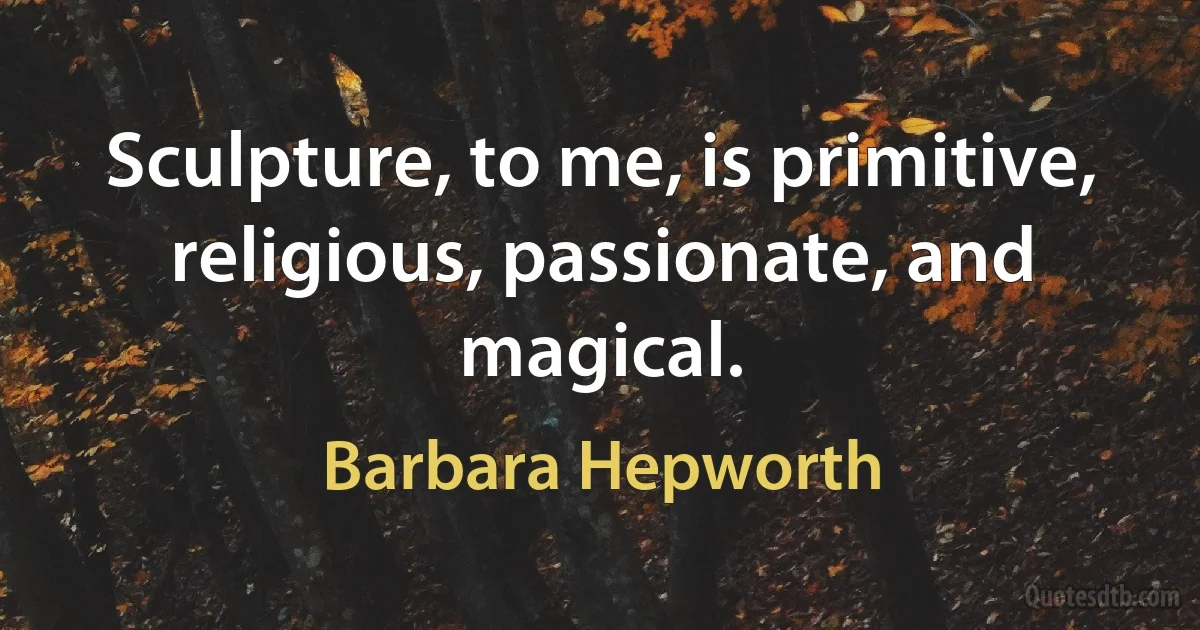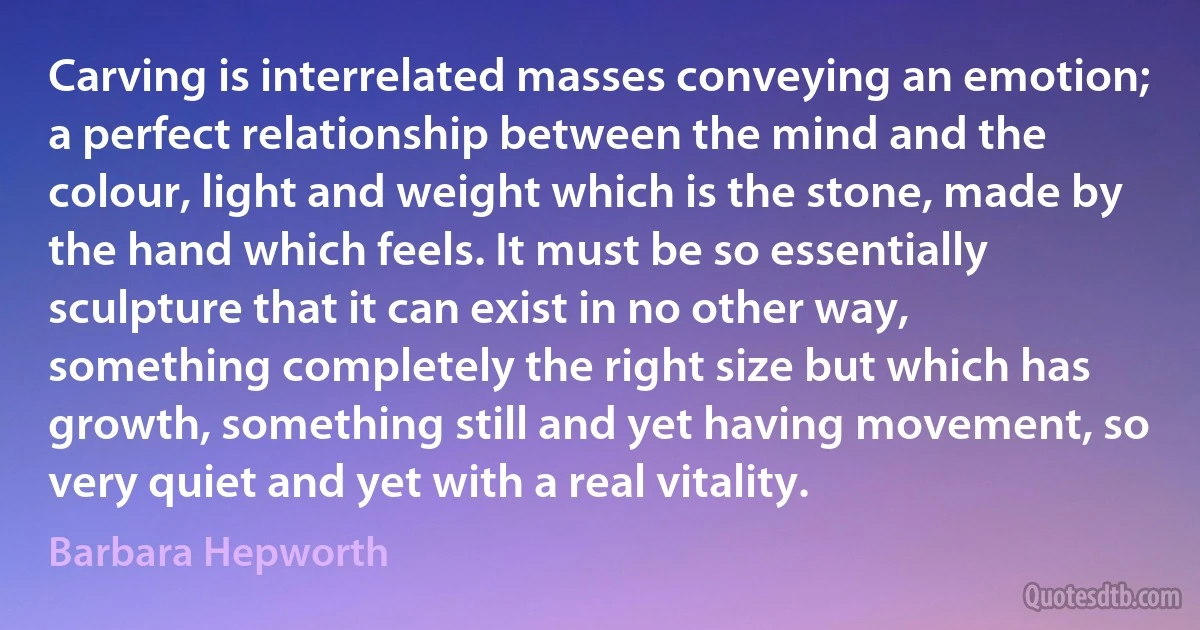Barbara Hepworth quotes - page 2
Barbara Hepworth was an English artist and sculptor renowned for her modernist abstract works. Her innovative techniques and organic forms greatly influenced twentieth-century sculpture. She achieved international acclaim and remains a key figure in the history of modern art. Here are 48 of her quotes:
I have been deeply interested during the last ten years in the use of colour with form. I have applied oil colour – white, grey, and blues of different degrees of tone... I have been very influenced by the natural colour and luminosity in stones and woods and the change in colour as light travels over the surface contours. When I pierced the material tight through a great change seemed to take place in the concavities from which direct light was excluded. From this experience my use of colour developed.

Barbara Hepworth
My left hand is my thinking hand. The right is only a motor hand. This holds the hammer. The left hand, the thinking hand, must be relaxed, sensitive. The rhythms of thought pass through the fingers and grip of this hand into the stone. It is also a listening hand. It listens for basic weaknesses or flaws in the stone; for the possibility or imminence of fractures.

Barbara Hepworth
I do not want to make a stone horse that is trying to and cannot smell the air. How lovely is the horse's sensitive nose, the dogs moving ears and deep eyes; but to me these are not stone forms and the love of them and the emotion can only be expressed in more abstract terms. I do not want to make a machine that cannot fulfil its essential purpose; but to make exactly the right relation of masses, a living thing in stone, to express my awareness and thought of these things.

Barbara Hepworth
I loved the family and everything to do with them. I loved the environment and the cooking. I used to cook and go in my studio. I had to have methods of working. If I was in the middle of a work and the oven burned or the children called for me, I used to make an arrangement with music, records, or poetry, so that when I went back to the studio, I picked up where I left off. I enjoyed it, you see; it was part of me.

Barbara Hepworth
I cannot write anything about landscape without writing about the human figure and the human spirit inhabiting the landscape, for me, the whole art sculpture is a fusion of these two element – the balance of sensation and the evocation of man in his universe. Every work in sculpture is either a figure I see, or a sensation I have, whether in Yorkshire, Cornwall or Greece, or the Mediterranean.

Barbara Hepworth
Our sense of touch is a fundamental sensibility which comes into action at birth – our stereognostic sense – the ability to feel weight and form and assess its significance. The form which have had special meaning for me since childhood have been the standing form (which is the translation of my feelings towards the human being standing in the landscape) the two forms (which is the tender relation of one living thing besides another); and the closed form, such as the oval, spherical or pierced form (sometimes incorporating colour) which translates for me the association and meaning of gesture in landscape; in the repose of say a mother and child.... In all these shapes the translation of what one feels about man and nature must be conveyed by the sculptor in terms of mass, inner tension, and rhythm, scale in relation to our human size and the quality of surface which speaks through our hands and eyes.

Barbara Hepworth
Working in the abstract way seems to release one's personality and sharpen the perceptions so that in the observation of humanity or landscape it is the wholeness of inner intention which moves one so profoundly. The components fall into place and one is no longer aware of the detail except as the necessary significance of wholeness and unity.... a rhythm of form which has its roots in earth but reaches outwards towards the unknown experiences of the future. The thought underlying this form is, for me, the delicate balance the spirit of man maintains between his knowledge and the laws of the universe.

Barbara Hepworth
'Circle' was published at last [constructivist manifesto, in 1937 - with Naum Gabo, Ben Nicholson a.o.]. Mondrian has made his studio opposite so very beautiful, and his company was always inspiring, as it had been in Paris when we used to visit him. After a while he really seemed to our domestic scene. His studio and Ben's [the sculptor Ben Nicholson; Barbara was his wife then] were most austere, but my studio was a jumble of children, rocks, sculptures, trees, importunate flowers and washing.

Barbara Hepworth
There is an oval sculpture of 1943. I was in despair because my youngest daughter, one of the triplets, had osteomyelitis. In those days the war was on and you couldn't get anything. She was ill for four years. I thought the only thing I can do to help this awful situation, because we never knew if it would worsen, is to make some beautiful object. Something as clean as I can make it as a kind of present for her. It's happened again and again. When my son died, he was killed [in the war], it's the only way I can go on.

Barbara Hepworth
A chance remark by Ardini, an Italian master carver whom I met there [in Rome], that 'marble changes colour under different people's hands' made me decide immediately that it was not dominance which one had to attain over material, but an understanding, almost a kind of persuasion, and above all greater co-ordination between head and hand. This thought has recurred again and again ever since - and has developed my greatest interests; the reason why people both move differently and stand differently in direct response to changed surroundings; the unconscious grouping of people when they are working together, producing a spatial movement which approximates to the structure of spirals in shells or rhythms in crystal structure; the meaning of the spaces between forms, or the shape of the displacement of forms in space, which in themselves have a most precise significance. All these responses spring from a factual and tactile approach to the object.

Barbara Hepworth
Barbara Hepworth
Occupation: English ArtistBorn: January 10, 1903
Died: May 20, 1975
Quotes count: 48
Wikipedia: Barbara Hepworth













